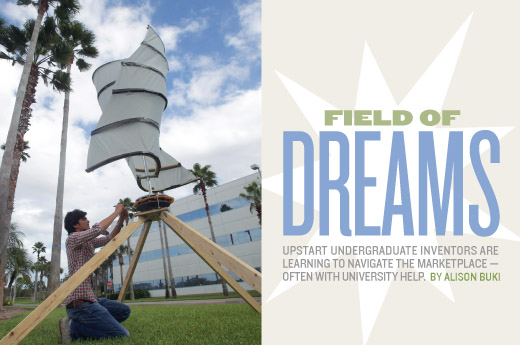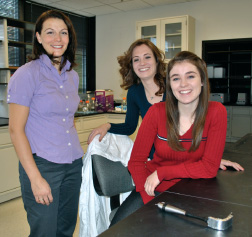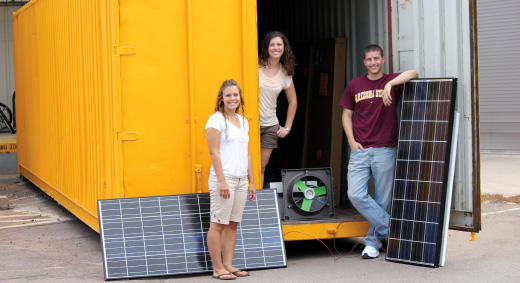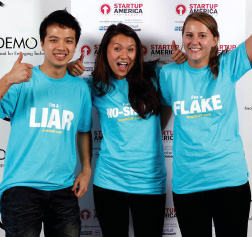Field Of Dreams

Wind turbine invented by Embry-Riddle Aeronautical University student Manu Sharma. Photo by David Massey, DAYTONA BEACH NEWS-JOURNAL
IT WAS A CLASSIC EUREKA MOMENT.
Browsing in an antique store on vacation two years ago, Embry-Riddle Aeronautical University senior Manu Sharma chanced upon a display of spiraling front-porch adornments known as wind twisters. Inspired, he thought: Why not make a wind turbine shaped like this? Sharma explained the idea to his honors-program professor, who encouraged him to seek university funding. That initial $1,000 grant spurred Sharma’s zest for entrepreneurship — and a start-up to develop and distribute his innovative power generator. Launched in early 2011, Nuovo Wind now has three classmates plus a faculty member on board, private investors, and a potential first customer: the Tanzanian government.
Step aside, Bill Gates. The days of dropout turned entrepreneur may be numbered. More than half of U.S. millennials (ages 18 to 34) say they want to start a business or already have done so — and engineering schools are striving to accommodate them. Some now host start-up workshops with business schools. Others have created venture funds and mentor networks. A few even built entrepreneurship centers to promote a culture of invention — including, in Stanford University’s case, within undergraduate engineering education. All told, roughly two thirds of 2,000 U.S. colleges and universities surveyed by the Kauffman Foundation currently offer entrepreneurship courses and activities. Engineering schools comprise a robust share: A recent Journal of Entrepreneurship Education study of 160 campuses by Cornell University researchers found nearly half the undergraduate engineering programs house some form of entrepreneurship activities.
The increase in entrepreneurial offerings means that the next Facebook founder need not choose between earning a degree and chasing a start-up dream. At Arizona State University, for instance, applications for the Edson Student Entrepreneur Initiative, a six-year-old program that gives student teams funding, office space, mentors, and training, soared 32 percent from 2010 to 2011, with some 30 teams receiving seed money — eight more than the previous year. Many student entrepreneurs become “serial inventors,” says Phil Weilerstein, executive director of the National Collegiate Inventors and Innovators Alliance, a National Science Foundation-supported nonprofit that engages 5,000 student entrepreneurs on 200 member campuses each year and, over the past 15 years, has helped launch more than 130 student-led companies. Of 40 patents obtained by these ventures, undergraduates claimed more than half.
“A lot of the panacea for this economy is to train students to be entrepreneurs, and to create jobs, not just take jobs,” says Nathalie Duval-Couetil, executive director of Purdue University’s Certificate for Entrepreneurship and Innovation Program. Launched in 2008 as part of a multimillion-dollar grant from the Lilly Endowment, the program was designed to supplement or “turbocharge” undergraduate education. Today, more than 1,000 students — roughly 15 to 18 percent of them from engineering — are enrolled in the five-course series that covers every essential of starting a business, from pitching an idea to fundraising and marketing.
In fact, start-ups are the great American job machine, responsible for much of the nation’s job growth in recent years, a 2010 Kauffman Foundation analysis found. Without the entrepreneur’s drive to bring ideas to market, “an ‘innovation’ is just a gizmo gathering dust in the lab,” Massachusetts Institute of Technology President Susan Hockfield told a Silicon Valley audience last year, noting that MIT’s alumni volunteer-run Venture Mentoring Service helped start 142 ventures that have raised $850 million in external financing over the past decade.
Other schools have hastened to improve the climate for entrepreneurs. In 2009, the University of Florida’s School of Engineering established the UF Engineering Innovation Institute, where students take a sequence of courses to build a broad range of skills, such as leadership, sustainable design, and business management. “It is intended to build a culture of innovation within the faculty, students, and staff,” says director Erik Sander. Last November, Harvard University opened the doors of its new Innovation Lab. The i-lab, as it is called, will provide both academic and meeting space (with Xbox gaming room and snack-filled refrigerator) for young entrepreneurs as well as host workshops, weekend “start-up scrambles” to pitch new ventures, and other efforts to promote business development.
The road from initial inspiration to up-and-running company is often rocky and unpredictable, especially for young inventors with little to no business experience. Having the support of mentors, professors, and now entrepreneurship institutions within schools gives undergraduates a better shot. From research grants to fully integrated “invention classes,” universities are sending the message that engineering students can succeed as entrepreneurs.
SURVIVAL OF THE CLEVEREST
Manu Sharma’s trajectory from Embry-Riddle aerospace engineering major to postmodern wind-turbine designer – and head of a fledgling firm with $50,000 in venture capital – was anything but straightforward. It began with an entrepreneurial professor who encouraged him to develop his spark of an idea using a $1,000 school research grant.
To come up with a turbine that was both maximally efficient and inexpensive to make, Sharma employed a Darwin-like theory called evolutionary design optimization. The method involves generating a large number of potential designs on computer software and then using special algorithms to select the most “fit.” Using an open-source CAD program and developing his own evolutionary algorithms, Sharma ran through hundreds of designs, selecting the most efficient ones to “mate” — combine specific traits of two designs, like genetics — and produce even more fit “offspring.” He pursued his project fervently, doing most of his work outside of class and sometimes gathering advice from professors. “If I had free time between classes, I would grab a laptop and work on my code,” he says. Once he had perfected a small-scale model, Sharma applied for and won a second university research grant – for $7,500 – to fund a prototype.
Sharma’s wind-turbine design wasn’t the only thing that evolved. He also had to learn how to pitch his idea to potential investors and develop a sensible business plan. He gained this experience by “pretty much applying to all the clean-tech competitions I could find,” he says. Though he failed to win any, Sharma gained valuable experience presenting his invention to potential backers. More crucially, he learned that developing countries offered the best target market for his low-cost turbines, which can generate the same amount of electricity for one quarter the price of a traditional $10,000 wind turbine.
In early 2011, Sharma, now a fourth-year student, officially launched Nuovo Wind to make and distribute the turbines. Soon afterward, he was admitted to the prestigious Kairos Society, a nonprofit dedicated to providing the most talented young entrepreneurs with opportunities to network with global industry leaders. The experience further stoked Sharma’s passion for entrepreneurship, and his enthusiasm spread: Three classmates, also Embry-Riddle seniors, as well as his electrical and computer engineering professor, Brian Butka, signed on to the start-up. Now, in addition to private investors, the Tanzanian government has expressed interest in Nuovo Wind’s innovative turbines.
In many ways, Sharma followed the traditional, self-taught path many students have taken over the years. But now, thanks to the recent crop of entrepreneurship-focused curriculum options, more budding engineers are innovating inside as well as outside the classroom.
EVERYTHING ILLUMINATED
An appropriately named INVENT! class gave University of Utah bioengineering majors Jessica Ashmead and Annicka Carter, both 20, the idea of starting a business. This novel approach to an introductory engineering course was designed in 2009 by Patrick Kiser, an associate professor of bioengineering. Students attend twice-a-week lectures on bioengineering fundamentals, while on Fridays they hear from a variety of innovators on topics ranging from acquiring patents to applying for grants. At the end of the course, students can opt to devise a theoretical solution to a current problem in the field instead of taking a final exam. Ashmead and Carter, friends and roommates, grabbed the first option — then took their project several steps further.

Holly Holman, Jessica Ashmead, and Annicka Carter are behind OptiGuide, a new medical device for lighting incisions during surgery. Photo Courtesy University of Utah Technology Venture Development
Their invention is based on “an idea that’s fairly simple but extremely important,” says Carter. It’s a lighted surgical retractor. The instrument, widely used in surgery to hold incisions open, has several lighted versions on the market today. But most need A/C power cords, which often get in the way during surgery and can be difficult to sterilize. Many retractors are thus designed to be disposable. Ashmead and Carter’s battery-powered retractor uses built-in LEDs as a light source. The OptiGuide, as they named their design, is reusable — all parts are easy to sterilize — and offers surgeons a portable, sustainable, and efficient way to light surgical cavities.
Beyond creating a fully functioning prototype, Ashmead and Carter found patenting their idea to be one of their main challenges. “Being able to come up with exactly what your patent will claim is really difficult when there are so many [pre-existing] patents on little parts of your idea,” Carter says. Fortunately, the INVENT! class and the university’s Technology Commercialization Office provided connections to legal experts. The pair credit their bioengineering instructor turned adviser, Holly Holman, with being a mentor throughout the process.
To raise funds to develop their idea, the OptiGuide team members, like many young innovators, turned to student competitions with cash prizes. Utah’s INVENT! course encourages participation in such contests and feeds into a statewide invention contest called techTITANS that Ashmead and Carter entered as part of the class. Though they didn’t win, the experience motivated them to “enter as many competitions as we could,” says Carter. They went on to win honorable mention and $5,000 in the national Collegiate Inventors Competition, sponsored by Kauffman, the U.S. Patent and Trademark Office, and the Abbott Fund, a nonprofit arm of the global healthcare company. Although Ashmead and Carter both are full-time students with part-time jobs, they insist OptiGuide has become their true passion. “We love it,” says Ashmead. “If we could choose to do anything when we get home from work and school, we would prefer to work on [OptiGuide],” agrees Carter. “If we could, we’d spend all of our time on this.”
DELIVERING HOPE
Courses need not focus explicitly on entrepreneurship to ignite student interest — and foster schoolwide collaboration. Consider Engineering Projects in Community Service, or EPICS, a service-learning program that originated in 1995 at Purdue and now has outposts on 20 U.S. campuses and more than 30 high schools. (EPICS High was featured in a December 2010 Prism article.)
At Arizona State University, which began offering the program in 2009, a series of three courses guide student teams through the steps of creating and deploying original engineering projects to help local or international communities and nonprofits. That’s how biomedical engineering major Gabrielle Palermo came to join forces with Susanna Young, a first-year grad student in mechanical engineering. They teamed up after discovering they’d been working independently on the same EPICS project: refurbishing empty shipping containers for use
in disaster relief and as mobile medical clinics in developing countries.
The professional aspects proved as engaging as the technical challenges. “Being part of a team, learning how to present… how to network,” says Palermo. “You’re just learning all these skills that you wouldn’t get in a regular engineering class.” With teammates John Walters, a fourth-year mechanical engineering student, and Clay Tyler, who is pursuing a master’s in the same field, Palermo and Young pooled their resources and applied for funding through the Edson Student Entrepreneur Initiative, a program that provides $200,000 annually to ASU student business ventures. Their idea, called the G3Box (the three G’s stand for “Generating Global Good”), won $10,000 in seed money. The team was thrilled. “It was like, yeah, people really like the idea,” Palermo recalls. “You can get kind of far with this!”

Gabrielle Palermo, Susanna Young, and Clay Tyler assembling a G3Box. Photo Courtesy Arizona State University.
G3Box was born from a need to bring safe, modern, and sustainable medical care to underdeveloped countries, especially those suffering from high maternal death rates. Many hospitals and international aid organizations lack the space and resources to expand their services, the ASU team discovered. That’s where G3Box’s key innovation comes in. Ports worldwide have a surplus of large empty shipping boxes that are prohibitively expensive to send back. By outfitting these spaces with medical equipment, potable water, and solar panels, the team is repurposing waste while providing accessible medical care for those in need.
The G3Box team describes the venture as a “more than profit organization” on its Facebook page. Indeed, the business is a model of social entrepreneurship: For every six boxes sold for disaster relief, G3Box can donate a maternity clinic to the developing world, where 99 percent of all maternal deaths occur. Palermo and her team have been hustling to finish their first maternity-clinic prototype for shipment to Kenya, where the maternal death rate is 50 times that of the United States. “Its main goal is to save as many lives as possible,” she says.
The team’s passion and hard work continue to pay off. Recently they were named “College Entrepreneurs of the Year 2011” by Entrepreneur magazine. In the future, G3Box plans to provide medical training to recipients and also may explore other uses for the shipping crates, such as mobile classrooms or libraries. Although Palermo and her teammates, like many young entrepreneurs, did not expect to start a business in college, she claims that G3Box developed naturally out of their shared interest in improving the world. “We all have the same values: trying to help people. I think all of us went into engineering for that reason,” she reflects. “It’s just interesting that we took that, spun it a bit, and now we’re trying to run a business.”

Partners Grady Laksmono, Fei Xiao, and Anna Sergeeva Photo Courtesy Demo Conference/Flickr
NO FUSS, NO FLAKES
While many student-led companies spring from a bolt of inspiration, Grady Laksmono’s grew out of a simple E-mail. Last year, Laksmono, then a computer science and engineering graduate student at the University of Southern California, responded to a message from USC’s business school looking for software engineers to help with a student Web venture. Thus trueRSVP was born.
Any party planner frustrated by trying to predict how many people will actually show up can appreciate the premise of trueRSVP: “Flake-proof your event.” (Flake is slang for someone who bails out at the last minute.) The new Web-based service, launched in the fall of 2011, promises accurate head counts based on a proprietary algorithm that gleans data on invitees. Unlike Facebook, Evite, or other online event-organizing tools, trueRSVP awards points and badges to guests who go to each event, while QR (quick-response) codes, which can be read by cellphones, allow hosts to keep track of attendees. The more events a user participates in or hosts, the more accurate trueRSVP’s predictions of both overall attendance and the reliability of individual guests. Given that nearly 1.7 billion invitations will be sent this year for nearly 60 million events planned online, the market has promise.
Anna Sergeeva and Fei Xiao, trueRSVP cofounders and entrepreneurship minors at USC, say they brought Laksmono on board with their project right away, impressed by his “enthusiasm and drive.” Like Manu Sharma, Laksmono spent many hours — even a Hawaii vacation — coding and debugging a program he had built from scratch.
Laksmono’s story holds inspiration for engineers who are looking to break into entrepreneurship but have yet to stumble upon their own “big idea.” By teaming up with business school students, he was spared the stress of learning how to pitch and market a new product.
TrueRSVP caught the eye of an angel investor and made its debut last September at — where else? — a Silicon Valley start-up showcase. Xiao, in a wedding gown, played the jilted bride: “Has anyone seen my groom? He was a no-show at the altar.” In tracking attendance, it scored a hit. Now, Sergeeva and Xiao see opportunities in trying to make the overall event planning process easier. Xiao clearly sees a marketing strategy: “We want trueRSVP to become the go-to site for all your event planning needs.”
Alison Buki is an ASEE staff writer.
Category: Cover Story Features